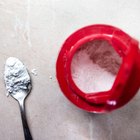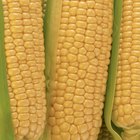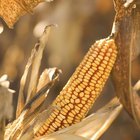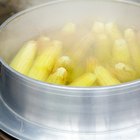
Several traditional preparations for dry corn require it to be treated with strong alkali, referred to as "nixtamalization" from the old Aztec term for the process. It leaves the corn more nutritious and digestible, ready to use as hominy or mill for grits or masa. A strong chemical called lye is traditionally used to make the hominy, but baking soda provides a safer and easier alternative.
Why Nixtamalize
Anyone who's ever eaten corn knows that its seed coat, or pericarp, is durable enough to whisk a kernel through the digestive system completely intact. That's admirable, given that its primary purpose is to protect the corn seed from damage, but corn that doesn't digest has no value as a food. Removing the seed coat makes the corn more available to the digestive system, but the strong alkali has a second purpose as well: It alters the corn's cellular structure to make B vitamins, especially niacin, more accessible to the human body. In cultures where corn is the daily staple, nixtamalization prevents a debilitating vitamin-deficiency illness called pellagra.
Lye vs. Baking Soda
The alkaline chemical usually used to strip the corn is called lye, or sodium hydroxide. Food-grade lye has to be ordered from specialized suppliers, and it's extremely potent. It can cause serious skin irritation, especially if it splashes on the delicate membranes of your eyes or nostrils. Many traditional-food enthusiasts, who would otherwise relish the opportunity to make their own hominy, are deterred by this. You can achieve the same effect with other alkaline chemicals, such as baking soda, which are less risky and intimidating.
Making Hominy
To make the hominy, you'll need a large stainless steel pot. Aluminum reacts chemically with the soda, so don't use it. The ratio of water to soda to corn is easy to remember. You'll need 1 tablespoon of baking soda for every 1 quart of water, and 2 quarts of water for every 1 quart of dry field corn you wish to process. Open your windows and turn on the range hood fan, and bring the soda solution to a full boil. Boil the corn for 30 minutes, stirring periodically to keep it from sticking, then let it stand for at least 20 minutes. Drain the corn and rinse it with several changes of hot water to remove the soda, then cold water to cool it.
Finishing the Job
To finish making your hominy, place the corn in a bowl under running water and rub it between your hands, so the hulls slide off. Slip the bare kernels into a colander, and rinse them thoroughly. Boil the hominy in clean, fresh water for five minutes, then drain it and change the water. Do this four times in total, to remove any lingering soda, then simmer the corn for 30 to 45 minutes until it has softened. The corn can be drained and frozen for later use, or canned in a pressure canner. Pint jars require an hour of processing at 11 psi, and quart jars require 70 minutes.
Related Articles

How to Make Hominy With Baking Soda

The Nutrition of Stone Ground Corn

How to Freeze Sweet Corn Off the Cob

How to Roast Corn in the Husk

How to Cook Oven-Roasted Corn

Why Is My Boiled Corn Chewy?

Nutrition Value of Corn Meal

How to Roast Frozen Corn With Olive Oil

How Long Do Ears of Corn Take to Roast ...

How to Freeze Corn on the Cob Without ...

How to Roast Corn in a Pan

How to Dry Corn on the Cob for Feeding ...

How to Dry Corn on the Cob

How to Freeze Fresh Corn on the Cob

How to Use Foodsaver for Freezing Corn

How to Make Breaded Shrimp With Corn ...

Is Corn Flour Considered Whole Grain?

How to Can Pickled Corn in Jars

How to Steam Frozen Corn on the Cob

Different Ways to Cook Whole Kernel Corn
References
- On Food and Cooking: The Science and Lore of the Kitchen; Harold McGee
- National Center for Home Food Preservation: Hominy Without Lye
Writer Bio
Fred Decker is a trained chef and prolific freelance writer. In previous careers, he sold insurance and mutual funds, and was a longtime retailer. He was educated at Memorial University of Newfoundland and the Northern Alberta Institute of Technology. His articles have appeared on numerous home and garden sites including GoneOutdoors, TheNest and eHow.
Photo Credits
Jupiterimages/Stockbyte/Getty Images